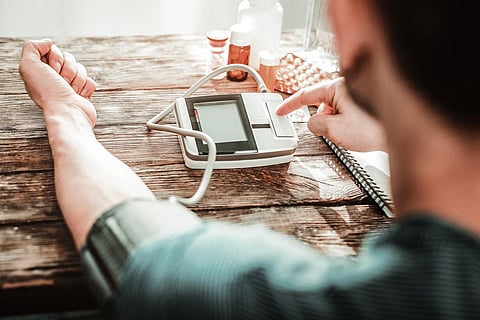MONDAY, Oct. 7, 2024 (HealthDay News) -- Checking your blood pressure at home? Pay attention to arm position.
A new study by Johns Hopkins researchers confirms that it makes a "huge difference" when it comes to getting an accurate measurement. And, the authors add, health care providers need to be more careful about it, too.
"[Patients] must advocate for themselves in the clinical setting and when measuring their BP at home," said senior study author Dr. Tammy Brady, vice chair for clinical research in the department of pediatrics at Johns Hopkins University School of Medicine.
Nearly half of U.S. adults have elevated blood pressure, according to the American Heart Association (AHA).
The diagnosis is made when the force of blood flowing through blood vessels is higher than normal (120/80, on average). Left untreated, hypertension puts a person at increased risk of stroke, heart attack and other serious heart conditions.
The new study looked at the effects of three arm positions during a blood pressure test: supported on a desk; supported on a lap; and hanging at the patient's side.
The study found that lap support overestimated systolic blood pressure (the top number in a blood pressure reading) by nearly 4 mmHg, while an arm hanging at the patients side overestimated it by nearly 7 mmHg.
Systolic pressure is the pressure against artery walls when the heart beats.
AHA guidelines for measuring blood pressure call for an appropriately sized cuff; back support; feet flat on the floor with legs uncrossed; and appropriate arm position.
What is that correct arm position? According to the AHA, the blood pressure cuff should be positioned at mid-heart level on an arm that is supported on a desk or table.
But researchers found that clinicians often measure blood pressure while patients are seated on an exam table with little, if any, arm support.
For the study, they recruited 133 adults from age 18 to 80. Participants were randomly assigned to one of six groups that differed by order of three seated arm positions. Before their blood pressure was taken, they emptied their bladder and walked for two minutes, then had a five-minute seated rest period with backs and feet supported.
Each had three measurements with the three seated positions. Between each set, they walked for two minutes and rested for five. They also had a fourth set of measurements with their arm supported on a desk.
Researchers found that measurements obtained with an arm on the lap or unsupported at the side were markedly higher than those obtained with the arm supported on a desk as recommended.
Supporting the arm on the lap overestimated pressure by 3.9/4.0. Unsupported arm at the side overestimated pressure by 6.5/4.4.
"If you are consistently measuring blood pressure with an unsupported arm, and that gives you an overestimated BP of 6.5 mmHg, that's a potential difference between a systolic BP of 123 and 130, or 133 and 140 -- which is considered stage 2 hypertension," said study author Sherry Liu, an epidemiology research coordinator at Johns Hopkins Bloomberg School of Public Health in Baltimore.
Her team noted that its results may only apply during screenings with automated blood pressure devices and not to those with other devices.
Nonetheless, Brady said in a Hopkins news release, the findings suggest that clinicians need to pay better attention to best practice guidelines.
The findings were published Oct. 7 in the journal JAMA Internal Medicine.
More information
The American Heart Association has more about high blood pressure.
SOURCE: Johns Hopkins Medicine, news release, Oct. 7, 2024


